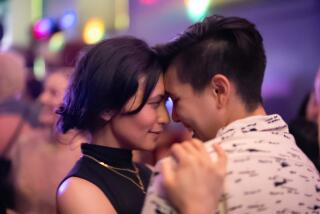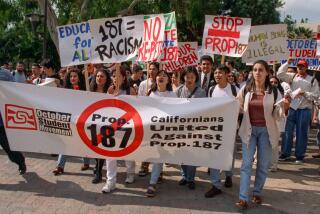Statistics on Gays Called Unreliable : Demographics: Some numbers paint a portrait of an affluent and educated community. But experts say the data ignores the hidden homosexual population and is based on poor sampling and ambiguous definitions.
- Share via
A news release from a Los Angeles gay advocacy group declares that 30% of youth suicides involve gay teen-agers.
An anti-gay rights group in Orange County, quoting newspaper articles, pegs the average household income of gays at $55,000 a year.
A promotional blurb for a Southern California business exposition refers to the $512-billion earning power of gays.
These are but a few of the numbers used these days to describe gay men and lesbians. Listen to a discussion of gay America and invariably someone will toss out a figure or two--usually with an air of sweeping authority.
Want to know what percentage of gay men are Republicans? There’s a number for that. What the median age of gays is? There’s a number. What percentage of lesbians go camping? There’s a number for that, too.
But where do all these statistics come from and how accurate a portrait do they present? How can one make such broad characterizations about a group that is partly hidden and whose size remains a matter of intense debate? For that matter, how do you define the gay population?
Such questions are increasingly being asked in and outside the gay community, in large measure because the numbers have taken on a politically charged life of their own. They are lobbed back and forth by advocates of every ideological stripe, often with little regard to their origins.
“I spend a significant amount of time explaining why these numbers are wrong,” said Gregory Herek, an associate research psychologist at UC Davis who studies gay-related issues. “The problem is that with very few exceptions, almost none of the data have been done with anything that even approaches representative samples.”
But politics and the media abhor a vacuum. What little information there is--much of it from marketing studies or popular surveys--has been plucked up and repeated until it assumes an aura of infallibility.
Take a figure routinely quoted by gay-youth advocates and the media: that 30% of all youth suicides may involve gays. The statistic--contained in a 1989 federal task force report on youth suicide--was gleaned from a variety of studies on attempted suicides, none of them nationally representative.
After being bombarded with inquiries about the figure, the agency that issued the report--the Department of Health and Human Services--took a closer look last year and concluded that there was no scientific evidence to support it.
Then there is the data developed by Simmons Market Research Bureau Inc. for the Advocate, a national gay magazine based in Los Angeles. The Simmons profiles of Advocate readers consistently show them to be young, well-educated, affluent professionals.
The figures apply to no more than the readership of a single gay magazine. “We have not undertaken a study for anybody of the gay community,” said Jerry Ohlsten, Simmons marketing director. Yet the Advocate profiles have been used over and over to describe the gay market and the entire gay community. Combined with demographics from a Chicago market research firm, Overlooked Opinions, they have created an upscale image that has stuck like flypaper to the nation’s gay population--to the growing annoyance of gay rights activists.
“This whole profile of a gay person being affluent, white and male is a bunch of nonsense,” said David Smith of the National Gay and Lesbian Task Force, a national gay rights organization based in Washington. “I think the gay and lesbian community is a mirror image of society as a whole.”
Ask Smith to back up that statement, and he faces the same dearth of information that plagues any attempt to characterize the nation’s gay men and lesbians. The U.S. Census Bureau, the basic source of national demographics, does not ask people about their sexual orientation. Attempts to identify gays in scientifically conducted polls are rare. Moreover, no survey taker can escape a fundamental limitation: To be counted, people have to somehow indicate they are homosexual.
“No matter what we do, we have a somewhat flawed sample,” said John Brennan, director of the Los Angeles Times Poll, which has surveyed gay voters in recent election exit polls. “The issue is whether people want to admit it to themselves. And no survey instrument is going to solve that.”
There is also a basic question of definition. Does the gay population consist of people who say they are homosexual, of people who have sex with people of the same gender, or of people who are sexually and emotionally attracted to the same gender, regardless of what they call themselves or whether they act on those feelings?
“Are we interested in openly gay people or are we interested in all people who have sex with someone of the same gender? That’s a different pool,” said Peter Nardi, a sociology professor who teaches research methods and statistics at Pitzer College in Claremont.
In the 1992 presidential elections, both The Times and Voter Research and Surveys--which polled for TV networks--included a question about sexual orientation in national exit poll surveys of voters. In each poll, about 3% of the respondents--who filled out questionnaires anonymously--said they were homosexual.
Although the samples are fairly small and confined to voters--who typically tend to be better educated and more affluent than the general population--they represent some of the first attempts to poll gays on a scientifically random, national basis.
In comparison to other voters, the exit surveys showed gays to be younger, somewhat better educated--and less well-off financially.
In The Times poll, 43% of the gay men had annual household incomes of $40,000 or more, compared to 48% of male voters as a whole. Similarly, 28% of the lesbians had household incomes of $40,000 or more, compared to 40% of all female voters.
The VRS poll of voters revealed only minor differences in the educational levels of gay men and all men, while lesbians were better educated than women as a whole.
Gay men and lesbians in The Times poll showed higher educational levels: 79% of gay men had gone beyond high school, compared to 69% of all male voters, and 75% of lesbians had attended college or graduate school--compared to 65% of all women voters.
The gay voters in both polls also tended to be young: 67% of gay men and 62% of lesbians in The Times poll were younger than 40.
The general tilt of gay demographics toward the young and the educated is seen by many as an incomplete picture. Rather than profiling all gays, these observers argue, the figures describe those who feel the most comfortable embracing a gay identity.
“I really don’t believe that going to school makes you a homosexual,” said Hunter College political science professor Kenneth Shirrell, who has studied gay survey samples. “Those data reflect who is secure enough in our society to say they are gay.”
Stuart Michaels, a University of Chicago researcher who surveys sexual behavior, makes a similar observation: “I would say among more highly educated people, in more professional surroundings . . . the social ethos is more liberal on these issues, so it’s easier to be out.”
Likewise, younger people--who have grown up with a blossoming gay rights movement--are more at ease with a gay label than older people who reached adulthood in an era of greater stigmatization.
A study undertaken by Lee Badgett, an assistant professor at the University of Maryland’s School of Public Affairs, also suggests that the gay yuppie portraits may be askew.
Badgett, a labor economist, turned to information collected by the University of Chicago’s National Opinion Research Center, which conducts a random national survey that questions adults on a broad range of topics, including sexual behavior.
Using the behavioral answers, Badgett identified respondents as homosexual, bisexual or heterosexual. Comparing people at the same education and age levels, she found that men who fell into the behaviorally gay/bisexual category earned 10% to 26% less than similar heterosexual men--a likely reflection, she says, of anti-gay discrimination.
Badgett also found that lesbians earned less than straight women, although because of the small size of the lesbian sample, she said those differences could be a matter of chance.
Amid the growing chorus of caveats, Jeff Vitale, president of Overlooked Opinions, raises a dissenting voice. He said Overlooked’s marketing data provides a good--if somewhat misinterpreted--snapshot of most of the gay population.
“The picture people tend to come away with is that the gay community as a whole somehow magically captured money and that is not true,” said Vitale, whose firm draws its figures from thousands of surveys distributed at gay events, gathering spots and to the readers of gay publications. “The critical difference is the household structure.”
He points to a variety of factors to explain the income and educational levels: Homosexual households are more likely to have two full-time wage earners than heterosexual families. Gay men and lesbians are drawn to urban areas, where salaries are higher, and gays have fewer family obligations, leaving them greater freedom to pursue their educations and obtain professional degrees.
“I’m astonished that the leaders in the gay movement adopt these sort of arguments, that they backpedal from what they really know is correct,” Vitale said, referring to criticisms of the upscale profiles.
Others remain unconvinced. “It may be accurate for urban, out, politically active and socially involved gays and lesbians,” sociology professor Nardi said. “(But) I don’t think we can say with any confidence what the profile of the lesbian and gay community is.”
Political Profile
The Los Angeles Times Poll included a question about sexual orientation in its national exit poll in the 1992 presidential election. Randomly selected voters who filled out an anonymous survey were asked to check a box if they were gay or lesbian. Three percent of the sample, or 267 men and 154 women, identified themselves as homosexual.
ETHNIC BACKGROUND
GAY MEN ALL MEN LESBIANS ALL WOMEN White 79% 85% 74% 83% Black 13% 9% 15% 12% Latino 4% 3% 7% 3% Asian -- 1% -- 1% Other 4% 2% 4% 1% AGE 18-39 67% 47% 62% 50% 40-64 29% 44% 27% 42% 65+ 4% 9% 11% 8% HOUSEHOLD INCOME Less than $20,000 22% 18% 38% 25% $20,000-$39,999 35% 34% 34% 35% $40,000+ 43% 48% 28% 40% POLITICAL AFFILIATION Democrat 66% 37% 67% 45% Republican 19% 36% 16% 35% Independent 14% 25% 15% 19% Other 1% 2% 2% 1%
Source: Los Angeles Times national exit poll, Nov. 3, 1992
More to Read
Sign up for Essential California
The most important California stories and recommendations in your inbox every morning.
You may occasionally receive promotional content from the Los Angeles Times.













